Engineers who design for extended-temperature applications like automotive designs should know about the four new opto-isolators from Avago that are just hitting shelves. All four take advantage of the company’s proprietary R2Coupler technology, which uses double-wire bonds to improve package robustness and reliability under harsh conditions (Fig. 1). 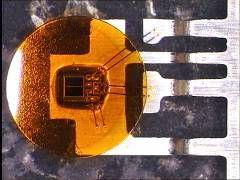
Modern automotive designs are integrating more advanced electronics every year. From engine-control applications to seat warmers, automotive processors rely on rugged and reliable I/O to assure safety and comfort.
This is true for internal combustion, electric and hybrid vehicles. While the controls and sensors may vary, it is important to protect the processor from spikes, glitches and ESD. Galvanic isolation is how cost-effective designers can achieve this. And this is where photovoltaic isolators come into play.
Photovoltaic isolators can be used for signal control and power control in both directions. From the micro-side, output signals can pass logic signals or control power loads depending on the output stages of the photovoltaic isolators. External power transistors, relays or solenoids can be driven by the outputs of the photovoltaic isolators that safely protect the micro’s logic line from the heavy spikes and glitches that can come from inductive loads like motors or solenoids.
On the way in, switches, status signals, timing signals like tachometers, and other conditions or states can be safely monitored by the micro using logic-compatible output stages or even open-drain or open-collector stages. Pulse-width-modulated signals can be used to pass analog values.
New in the mix
One of the four new parts from Avago is a high-voltage MOSFET driver that consists of an AlGaAs infrared-light-emitting-diode (10 – 20 ma If ) input stage optically coupled to an output-detector-array circuit (Fig. 2). The photovoltaic driver is turned on upon a minimum-input current of 10 mA through the input LED; it is turned off upon an input voltage of 0.8 V or less.
The ACPL-K30T comes in a fairly small stretched SO-8 package and uses a special photovoltaic diode array and a turn-off circuit that decreases the turn-off times and instantaneously discharges any charge in the gate capacitance of the MOSFET. It is specifically designed to drive high-voltage MOSFETs to let designers create their own solid-state relay tailored for specific requirements.
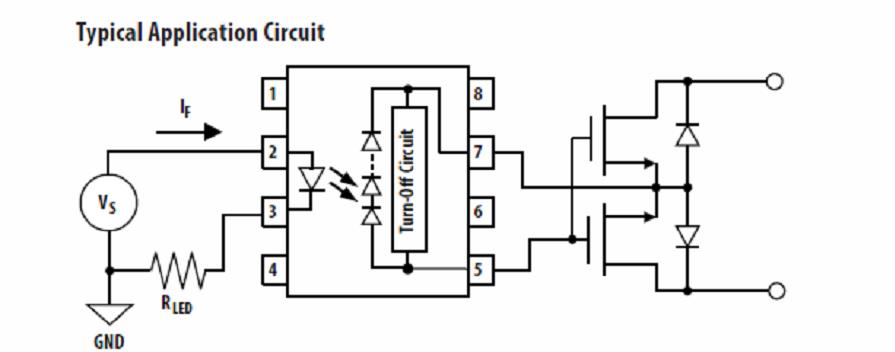
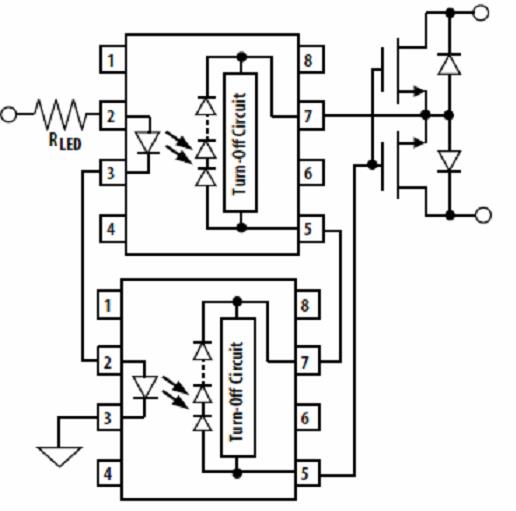
The ACPL-K30T typically exhibits an Open Circuit Voltage (VOC) of around 7 volts with a minimum VOC at 125°C of 4 Volts. This should be sufficient to drive most logic-gate-level MOSFETS. But, higher-voltage MOSFETS can also be used by cascading two ACPL-K30Ts in series, which ups this to a typical 14 VOC (Fig. 3).
Step up for power
AC-DC and DC-DC converters can step down or step up voltage levels as needed to bias and control other circuits, and to provide electrical power isolation as well as signal isolation. Opto-isolated gate drivers for IGBTs and power FETs serve these designs well, especially when fast-propagation delays and tight-timing skews are needed across wide-voltage ranges.
The new ACPL-K33T automotive also uses double-bonded R2 Coupler isolation inside the 2.5 Amp (peak output current) driver for Silicon Carbide (SiC) MOSFETs, and IGBT power transistors. The compact stretch SO-8 houses the high-current driver in a rail-to-rail configuration using LED threshold-based hysteresis. The 120 nsec propagation delay allows higher speed switching of the wide 15-to-30-Volt VCC power and features under-voltage lockout protection.
The discrete driver circuits can be strategically placed near inductors and take advantage of an anti-cross-conduction drive technique between the high and low side gate drivers. This protects against shoot-through events by interlocking output buffers (Fig. 4).
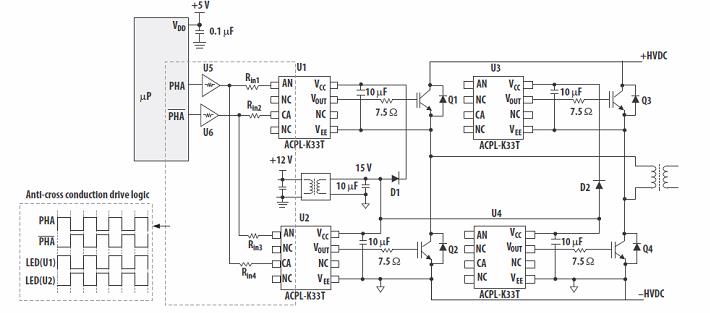
Diagnostics built in
When more than just power control is needed, the ACPL-344JT can combine isolated power control with built-in high-level diagnostics, as well as fault detection and protection. The ACPL-344JT is a highly integrated power controller for implementing a complete, isolated IGBT gate driver with high-noise immunity (Fig. 5).

Also using double-bonded R2 Coupler isolation, inside the relatively compact SO-16 package are a 2.5 Amp gate drive opto-coupler with fast propagation delays (250 nsec max) and common-mode rejection up to 1500 V levels. The device features a full set of fail-safe IGBT diagnostics, protection, and fault reporting.
Some nice features include IGBT desaturation sensing, soft shutdown, fault feedback, under-voltage lockout, and Miller current sinking clamping (1.9 A max) which provides a low-impedance path when output-voltage reaches around 2 Volts.
The ACPL-344JT is designed for use in a traction powertrain inverter, power converter, battery charger, air conditioner, and oil pump motor drive for electric vehicle (EV), hybrid electric vehicle (HEV) and plug-in hybrid electric vehicle (PHEV) applications and is compliant with automotive AEC-Q100 semiconductor requirements.
Sensing remotely
A rather clever device to consider for automotive applications is the ACPL-C797T, an optically isolated 1-bit, 2nd-order Sigma-Delta (Σ-Δ) modulator. The isolated modulator converts a low-bandwidth analog input into a high-speed 1-bit data stream by means of a Sigma-Delta (Σ-Δ) over-sampling modulator. The modulator data and on-chip sampling clock are encoded and transmitted across the isolation barrier, where they are recovered and decoded into separate high-speed clock and data channels.
An internal 10 MHz clock provides timing for the 16-bit resolution modulator. Using a 3-to-5-Volt supply range yields a +/- 200 mVolt analog linear-sense range with +/- 320 mVolt full scale.
Typical applications can include motor phase sense using isolated drive and sensing (Fig. 6).
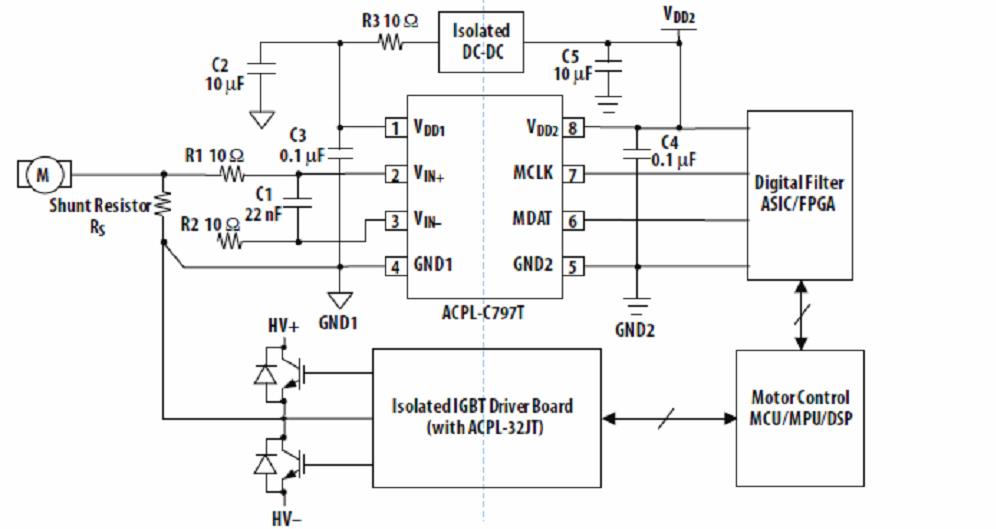
Driving away
These new members of Avago’s automotive opto-couplers can be important allies in the charge to create reliable, cost-effective designs for automotive and extended temperature range designs. Double bonded R2 Coupler technology improves package robustness and reliability under harsh conditions giving designers an edge.
Advertisement
Learn more about Avago Technologies





